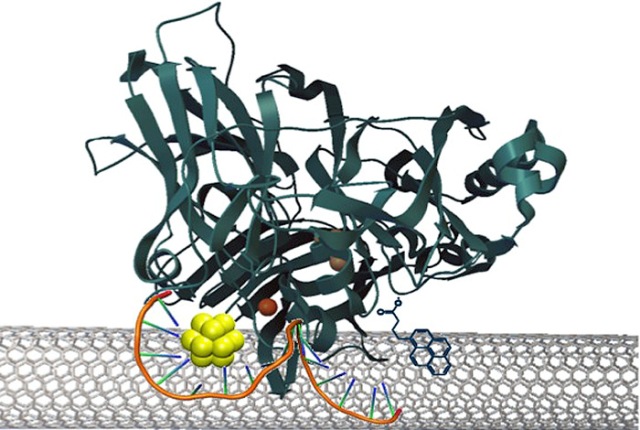With fossil-fuel sources dwindling, better biofuel cell design is a strong candidate in the energy field. In research published in the Journal of the American Chemical Society, Los Alamos researchers and external collaborators synthesized and characterized a new DNA-templated gold nanocluster (AuNC) that could resolve a critical methodological barrier for efficient biofuel cell design.
 Gold nanoclusters (~1 nm) are efficient mediators of electron transfer between co-self-assembled enzymes and carbon nanotubes in an enzyme fuel cell. The efficient electron transfer from this quantized nano material minimizes the energy waste and improves the kinetics of the oxygen reduction reaction, toward a more efficient fuel cell cycle.
Gold nanoclusters (~1 nm) are efficient mediators of electron transfer between co-self-assembled enzymes and carbon nanotubes in an enzyme fuel cell. The efficient electron transfer from this quantized nano material minimizes the energy waste and improves the kinetics of the oxygen reduction reaction, toward a more efficient fuel cell cycle.
“Enzymatic fuel cells and nanomaterials show great promise—and as they can operate under environmentally benign neutral pH conditions, they are a greener alternative to existing alkaline or acidic fuel cells, making them the subject of worldwide research endeavors,” said Saumen Chakraborty, a scientist on the project. “Our work seeks to boost electron transfer efficiency, creating a potential candidate for the development of cathodes in enzymatic fuel cells.”
Ligands, molecules that bind to a central metal atom, are necessary to form stable nanoclusters. For this study, the researchers chose single-stranded DNA as the ligand, as DNA is a natural nanoscale material having high affinity for metal cations and can be used to assembly the cluster to other nanoscale material such as carbon nanotubes.
In enzymatic fuel cells, fuel is oxidized on the anode, while oxygen reduction reactions take place on the cathode, often using multi copper oxidases. Enzymatic fuel cell performance depends critically on how effectively the enzyme active sites can accept and donate electrons from the electrode by direct electron transfer (ET). However, the lack of effective ET between the enzyme active sites, which are usually buried ~10Å from their surface, and the electrode is a major barrier to their development. Therefore, effective mediators of this electron transfer are needed.
The team developed a new DNA-templated gold nanocluster (AuNC) that enhanced electron transfer. This novel role of the AuNC as enhancer of electron transfer at the enzyme-electrode interface could be effective for cathodes in enzymatic fuel cells, thus removing a critical methodological barrier for efficient biofuel cell design.
Possessing many unique properties due to their discrete electron state distributions, metal nanoclusters (<1.5 nm diameter; ~2-144 atoms of gold, silver, platinum, or copper) show application in many fields.
Hypothesizing that due to the ultra-small size (the clusters are ~7 atoms, ~0.9 nm in diameter), and unique electrochemical properties, the AuNC can facilitate electron transfer to an oxygen-reduction reaction enzyme-active site and therefore, lower the overpotential of the oxygen reaction. Overpotential is the extra amount of energy required to drive an electrochemical reaction.
Ideally, it is desirable that all electrochemical reactions have minimal to no overpotential, but in reality they all have some. Therefore, to design an efficient electrocatalyst (for reduction or oxidation) we want to design it so that the reaction can proceed with a minimal amount of extra, applied energy.
When self assembled with bilirubin oxidase and carbon nanotubes, the AuNC acts to enhance the electron transfer, and it lowers the overpotential of oxygen reduction by a significant ~15 mV (as opposed to ~1-2 mV observed using other types of mediators) compared to the enzyme alone. The AuNC also causes significant enhancement of electrocatalytic current densities. Proteins are electronically insulating (they are complex, greasy and large), so the use of carbon nanotubes helps the enzyme stick to the electrode as well as to facilitate electron transfer.
Although gold nanoclusters have been used in chemical catalysis, this is the first time that we demonstrate they can also act as electron relaying agents to enzymatic oxygen reduction reaction monitored by electrochemistry.
Finally, the presence of AuNC does not perturb the mechanism of enzymatic O2 reduction. Such unique application of AuNC as facilitator of ET by improving thermodynamics and kinetics of O2 reduction is unprecedented.
Reference: “A Hybrid DNA-Templated Gold Nanocluster For Enhanced Enzymatic Reduction of Oxygen,” JACS DOI: 10.1021/jacs.5b05338.
Researcher affiliations: Saumen Chakraborty, Reginaldo C. Rocha, Anil Desireddy, Amy E. Boncella , and Jennifer S. Martinez (all with the Center for Integrated Nanotechnologies at Los Alamos, MPA-CINT); Sofia Babanova, Kateryna Artyushkova, Plamen Atanassov (Center for Micro-Engineered Materials, CMEM, and Department of Chemical & Biological Engineering, The University of New Mexico)
The study was enabled by a user proposal from the Center for Integrated Nanotechnologies, a DOE Office of Science User Facility (nanocluster design and synthesis) to the UNM team in addition to their Air Force Office of Scientific Research and the ARO-Multi-University Research Initiative grant (electrochemistry), in addition to funding from DOE’s Basic Energy Sciences Biomolecular Materials Program (assembly and characterization of assembly properties) and Los Alamos’s Laboratory Directed Research and Development Postdoctoral Fellowship (TEM/EDX analysis of nano clusters).